

Acknowledgements
Academic Authors: Muskan Panjwani, Alina Yakunina
Creative Directors: Alena Sizintseva
Book Production: Nazarova Aleksandra, Anastasia Voitovich
All products and brand names used in this book are trademarks, registered trademarks or trade names of their respective owners.
© Uolo EdTech Private Limited First edition 2026
This book is sold subject to the condition that it shall not by way of trade or otherwise, be lent, resold, hired out, or otherwise circulated without the publisher’s prior written consent in any form of binding or cover other than that in which it is published and without a similar condition including this condition being imposed on the subsequent purchaser and without limiting the rights under copyright reserved above, no part of this publication may be reproduced, stored in or introduced into a retrieval system, or transmitted in any form or by any means, electronic, mechanical, photocopying, recording or otherwise, without the prior written permission of both the copyright owner and the abovementioned publisher of this book.
Book Title: DinoLab Math Smartbook 2
ISBN: 978-93-89789-59-1
Published by: Uolo EdTech Private Limited
Corporate Office Address: 91Springboard, 3rd Floor 145, Sector 44, Gurugram, Haryana 122003
CIN: U74999DL2020PTC360472
Printed by: Printpro Solutions
All suggested use of the internet should be under adult supervision.
How to get access to DinoLab
Get access to animated interactive courses, Marathons, Olympiads, and much more — all in the Uolo Learn app!
1. Download the "Uolo Learn" app from Google Pay (Android) or AppStore (iPhone).
2. In the app click scanner to scan the QR code below.
Class:
Name:
School:
3. Follow the instruction in the app to access the content.
Welcome to DinoLab!
DinoLab is an AI-powered self-learning platform that helps children learn Mathematics and other subjects step by step, at their own pace. Students can practise and revise every topic digitally and through printed smartbooks.
The DinoLab Mathematics Smartbook is a companion to the digital course. Each exercise has a QR code linking to the Uolo Learn app for continued practice.
Using AI, DinoLab creates a personalised learning path: it explains the concept, gives guided practice, and adapts if mistakes occur — helping students gain clear understanding.
Digital content is presented as interactive flashcards with 50,000+ gamified exercises and animations, making learning engaging and enjoyable.
DinoLab works in Uolo apps and on multiple devices
To use DinoLab on the web, Smartboards, and in computer labs, your school will receive special access for each student and teacher.
Uolo Mobile App SmartboardComputer Lab Smartbooks Tablet and Laptop SMART
How to Use the DinoLab Solution
Once the Uolo Learn app is installed and you are logged in, you can access DinoLab. Our Mathematics course is designed with interactive exercises that help children cover the school syllabus step by step, at their own pace.
Compete and win in Marathons!
• Solve problems and earn points
• Leaderboards of your class, school and all of India
• Get achievement certificates
In this Smartbook, you will find QR codes placed next to the exercises. Simply use the QR scanner inside the app to access the interactive content. QR codes in the smartbook
1 2 3
1. Numbers up to 200 Understanding Numbers up to 200
1. Look at the picture and fill in the blanks.
One bar has 10 blocks.

There are 3 bars. Total blocks. Write the total number of blocks:


2. Look at the picture and write the answers.

Total number of apples:












Total number of apples:











3. Look at the picture and write the answers.
hundreds tens ones



Total number of blocks:
hundreds tens ones



Total number of blocks:
4. Look at the picture and write the answers.




Total number of pears:




Total number of apples:











More Types of Numbers
5. Look at the picture and fill in the blanks.
Total children. Blue team has hats.
6. Connect the words with the position. first second third
7. Look at the picture and circle the answers.

Who is in the first car?
dog cat
What position is parrot’s car?
What position is the last car?
fifth fourth second third
8. Connect the dinos and their sayings.
I am first! I am third!
I am fourth! I am fifth! I am second!
9. Circle the one who was the first at the finish line.
10. Look at the picture and mark the answer.
What position is the house with the red roof?
third second sixth
What position is the house with the purple walls?
third second fifth What is the colour of the walls of the second house?
11. Pairs and count the objects, circle the number is even or odd. I have 6 balls.







even




even odd even odd even odd balls cups cups
























12. Circle all incorrect pairs.




13. Circle all even numbers.


14. Circle all odd numbers.
2. Addition of 2-digit Numbers
1. Connect with line pairs of numbers to make 50. Adding 2 digit Numbers
2. Connect with line pairs of numbers to make 100.
3. Fill in the blanks and find the answer.
4. Solve the examples and write down the columns.
5. Complete these sums without regrouping. Start adding from ones.
6. Complete these sums with regrouping.
7. Fill in the blanks and find the answer.
8. Solve the examples and write down the columns.
3. Subtraction of 2-digit Numbers
1. Fill in the blanks and find the answer. Subtracting 2 digit Numbers
2. Solve the examples and write down the columns.
3. Complete these subtraction without regrouping. Start subtracting from ones.
4. Complete these subtraction without regrouping.
5. Fill in the blanks and find the answer. 3 0 76 4 tens +ones 0= 4tens + tens + ones ones = 3= –6 1tens+ones 7 7 = 44tens + tens + ones ones = 8= –
6. Solve the examples and write down the columns. 92 – 46 = 60 – 36 = 33 – 18 = 1
4. Multiplication
Understanding Multiplication
1. How many wheels do the bicycles have? Fill in the blanks.
How many similar numbers?
2 + 2 + 2 =
2. How many towers are in the castles? Fill in the blanks.
How many similar numbers?
3 + 3 + 3 + 3 = 3 x =
3. How many legs do the cows have?
Fill in the blanks.



4. How many pencils are there in the box? Fill in the blanks.
5. How many legs do the dogs have? Fill in the blanks.




+ 9 + 9 = 9 × = 4 + 4 + 4 + 4 + 4 = × 5 =

6. How many legs do the chairs have?
Fill in the blanks.
3 + 3 + 3 + 3 = 3 × =
7. How many legs do the spiders have?
Fill in the blanks.
8 + 8 + 8 = × =
8. How many ears do the rabbits have?
Fill in the blanks.





2 + 2 + 2 + 2 + 2 = × =
9. Write the number of crystals in two ways.
10. Write the multiplication sentence.
11. Circle all expressions that match with the picture.








2. Cross out the incorrect examples (x).
× 5 = 50 5 × 5 = 20
× 8 = 40 5 × 3 = 15
3. Fill in the blanks. 4 × 2 = 8 2 × 9 = 36 2 × 4 = 16
× 2 = 12
6. Numbers up to 999
Understanding Numbers up to 999
1. Circle the correct names of numbers to make its name.
2. Read and help octopuses to writethe correct number of their children.

Nine hundred thirteen

Two hundred and fifty eight

Three hundred and eight

Eight hundred and sixty-seven
3. Look at the picture and fill in the blanks.
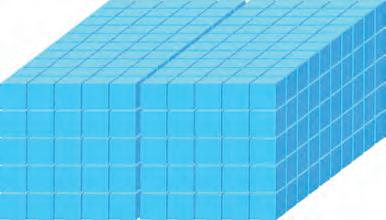





4. Circle the correct numbers.
5. Fill in blanks to make number like sum of the place values.
Comparing and Forming Numbers
6. Write a 3-digit numbers using the parts below.
7. Draw the way for monkey to get fruits.
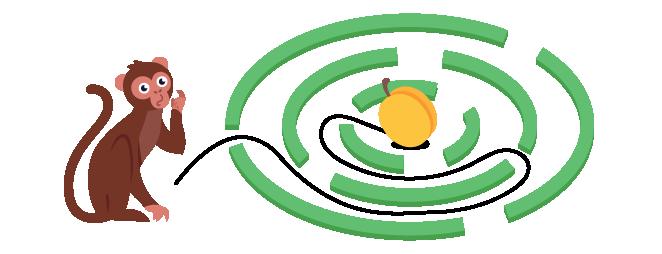


8. Read and connect the octopus with their children.


9. Add +100 and find the way for knight — circle the correct way.


7. Addition and Subtraction of 3-digit Numbers
Operations on 3-digit Numbers
1. Complete these sums without regrouping.
2. Complete these sums with regrouping.
3. Connect with line pairs of numbers to make 500.
4. Connect with line pairs of numbers to make 1000.
5. Solve the examples and write down the columns without regrouping.
231 + 168 =
711 + 78 =
628 + 160 =
6. Solve the examples and write down the columns with regrouping.
287 + 168 =
238 + 78 =
618 + 175 =
7. Complete these subtraction without regrouping.
8. Complete these subtraction with one regrouping.
9. Complete these subtraction with two regrouping.
10. Complete these subtraction with zero in the middle.
11. Complete these subtraction from tens.
12. Solve the examples.
Solving Word Problems on Addition and Subtraction
13. Solve the problems and fill in the blanks.

Nina ran the first lap in 4 minutes, and the second one 2 minutes longer. How many minutes did Nina run the second lap?
Answer: Nina ran the second lap in minutes.

4 + 2 = (min) – =
Crab has 10 legs, and bee 4 fewer. How many legs does a bee have?
Answer: The bee has legs. (l.)
14. Look at the picture and solve the problem.
Kirti has 4 blue balloons and 3 pink ones. How many balloons does Kirti have?
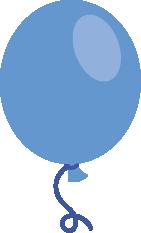






Answer: Kirti has a total of balloons. ?
15. Circle the correct solution of the problem.
At the edge of the forest 7 rabbits were walking, 4 rabbits ran away. How many rabbits are left at the edge of the forest?
+ 4 = 11 (r.)
Sonia made 6 paper lanterns, and Garima made 3. How many lanterns did dinosaurs make? 8 – 5 = 3 (r.)
– 3 = 3 (l.)
+ 3 = 8 (l.)
– 4 = 3 (r.)
+ 3 = 9 (l.)
16. Solve the problems and write the answers.
During the tour, Sonia took 6 photos. And Garima took 3 photos more. How many photos did Garima take?
Answer:
Masha made 8 braids. Gita made 2 braids. How many more braids did Masha braid than Gita?
Answer:
Kirti solved 4 problems in mathematics. And Kaustubh solved 1 more problem. How many math problems did the children solve in total?
Answer:
On Wednesday, Sonia wrote down 5 vocabulary words. On Thursday, she wrote 3 more words. How many vocabulary words did Sonia write on Thursday?
Answer:
2. Cross out the incorrect examples ( ).
3. Fill in the blanks. 3 × 6 = 18
= 48
Multiplication 2-digit Numbers
5. Find the product by decomposing it into small terms.
23 × 4 = (20 + 3) × 4
23 × 4 = 20 × 4 + 3 × 4
23 × 4 = 80 + 12
23 × 4 =
32 × 2 = × 2 + × 2 = + =
6. Circle every equal part of the expression to cross the river.
7. Connect with line the equal expressions.
× (3 + 4)
× (4 + 2)
× (3 + 2)
× (2 + 6)
× 3 + 4 × 2
× 3 + 2 × 4
8. Complete these multiplication.
9. Solve the expressions.
9. Introduction to Division
Understanding Division
1. Connect with line the pictures with their number sentences.




































































2. Write an expression and solve it. 12 ÷ = 4






































4 =
÷ =
=
=
How to Divide
3. Circle a picture according to the expression.


























































































4. Write an expression and solve it.

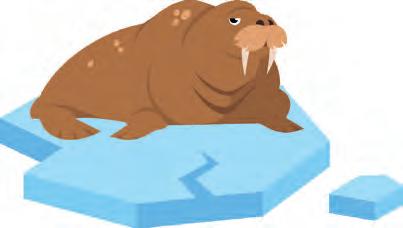
14 ÷ 2 =
I have 14 fish, divided equally into 2 groups. How many fish are in one group? ÷ =
I have 12 shells, divided equally into 6 groups. How many shells are in one group?
÷ 6 =

I have 12 fish, divided into 3 fish in each group. How many groups do I have?

I have 4 groups with fish. I have the same number of groups, but with 5 fish in each. How many fish do I have in total?
x =
5. Connect with line the names with correct numbers.
6. Connect with line what number 4 is in every sentence.
7. Circle all the number sentences where the following condition is met.
Number 12 is the dividend
12 ÷ 3 = 4 36 ÷ 12 = 3
12 ÷ 2 = 624 ÷ 2 = 12
Number 4 is the divisor
4 ÷ 2 = 212 ÷ 3 = 4
12 ÷ 4 = 38 ÷ 4 = 2
Number 6 is the quotient
12 ÷ 2 = 6 18 ÷ 3 = 6
6 ÷ 2 = 312 ÷ 6 = 2
8. Circle all the sentence wherethe following condition is met.
Number 8 is the dividend
? ÷ 2 = 416 ÷ 2 = ?
24 ÷ ? = 3
Number 10 is the divisor
30 ÷ 3 = ? ? ÷ 2 = 5
20 ÷ ? = 2
Number 9 is the quotient
? ÷ 3 = 3 18 ÷ ? = 2
27 ÷ 3 = ?
9. Write a number sentence according to the condition and find the quotient.
The dividend is 8, the divisor is 2
The dividend is 12, the divisor is 3 ÷ ÷ = =
10. Solve the expressions.
10. Introduction to Fractions
Understanding Fractions
1. Circle all figures that are divided into equal parts.
2. Circle the figures that are divided into 2 halves.
3. Circle the figures that are divided into 3 equal thirds.
4. Circle the figures that are divided into 4 equal quarters.
5. Circle the word that describes the pictures. thirtieths quarters thirds halves two halves sevenths thirds quarters thirds thirteenths sevenths fifths sevenths quarters quartet quarters halves thirds fifths
6. Look at the pictures and fill in the blanks.



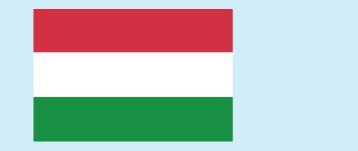

What fraction of the Austrian flag is white?
This is a marine flag meaning «Man overboard». What fraction of the flag is red?
This is a marine flag meaning «I need a tow». What fraction of the flag is black?
What fraction of the Hungarian flag is green?
This is a marine flag meaning «Turn right». What fraction of the flag is blue?
7. Connect by line each figure with their name of painted part.
One half One third One quarter
8. How much of figure is shaded? Write the fractions.
9. Shade the part of circle to match the fraction.
10. Circle all the shapes that match the fraction.
11 14
11. Connect by line the parts of fraction.
Denominator
Numerator
Fraction bar
12. Connect by line the pairs of fractions and the matching pairs. 87 and 33




Fractions with different numerators
Fractions with equal numerators
11. Measurement
Length
1. Count and complete the sentence.
This pencil box is sharpeners long
This box is paper clips long
This pencil is erasers long
2. Take a ruler and measure the length of the objects, write the answers in centimetres.
3. Draw a line segments 3 cm, 5 cm and 8 cm long.
4. Measure a line segments and write their length.
5. Draw a line segments equal to the sum of the length of the given line segments, write its length.
6. Draw a line segments equal to the difference of the length of the given line segments, write its length.
7. Write the length of the line segments.
8. Circle the segment 4 cm long.

9. Circle the segment 3 cm long.

10. Circle the segment 7 cm long.

11. Circle all standard units.
12. Draw a rectangle with sides 7 cm and 5 cm long.
1 cm
13. Find the length of the objects, write the answers.
15. Connect with line the pictures with correct scale. Weight
14. Circle all scales.
16. Look at the scales and write the weight of the objects and animals in the blanks.
17. Circle what is heavier.

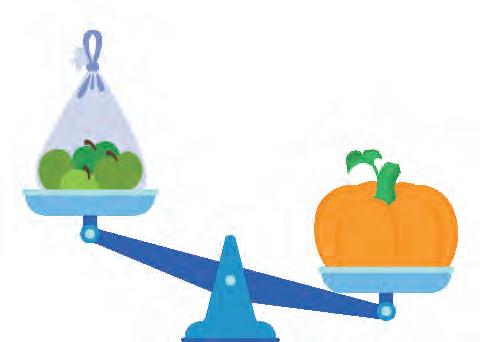


cat pumpkin
watermelon
18. Circle what is lighter.




brinjal
19. Find the weight of the animals.



20. Find the weight of ostrich egg. kg kg kg kg

21. Find the weight of the objects and fill in the blanks.

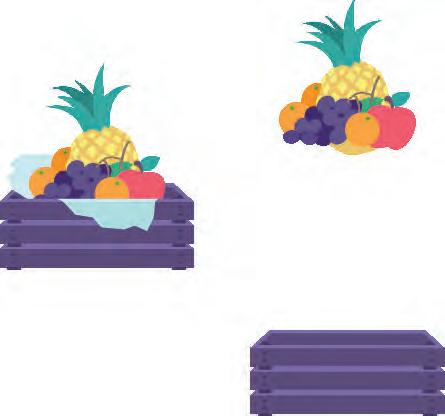
22. Fill in the blanks.
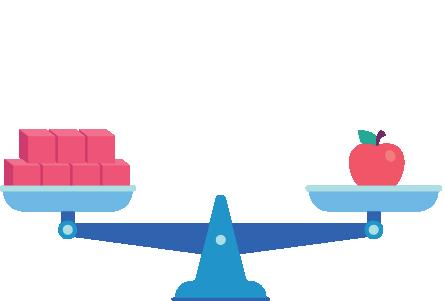
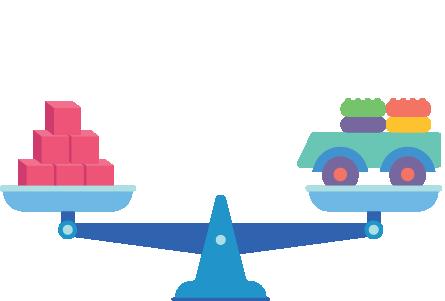
The weight of the apple is equal to blocks.
The weight of the toy is equal to blocks.
23. Count and fill in the blanks.

There are 2 L of milk, L of juice and L of water.

There are L of soap, L of washing powder and L of shampoo.
24. Circle the standard unit.
Bucket Litre Glass
25. Look at the picture and write how many cups and glasses are in the jar.



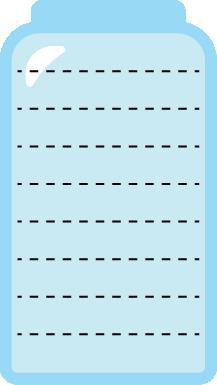



Put the comparison signs


Cup
26. Mark two points on the line.
So that total 7 litres.

Different total 7 litres

So that total 6 litres.

27. Look at the pictures and count.

There is 2 L of juice is left in the jar.
28. How much juice is left in the jar after filling the glasses?

There is L.
29. How much juice will remain in the right vessel after filling the left?


12. Shapes and Patterns
All about lines
1. Outline the shortest way between points and answer the questions.

How many different curves can be drawn through two points? Circle the answer
How many different straight line can be drawn through two points? Circle the answer
2. Connect with line the pictures and terms.
straight line
curve close figure straight line points curve
3. Colour the lines by the colours.

4. What is shown? Underline correct term for each picture.
closed figure / open figureclosed figure / line segment
straight line / point curve / straight line ray / curve ray / open figure
5. Circle the figure with 4 vertices and 3 line segments.
6. Circle the figure with 5 vertices and 5 line segments.
All about shapes
7. Connect with line the pictures and terms.

a closed polygonal chain a simple polygonal chain not a polygonal chain
8. Find and colour all polygons on the picture.
9. Look at the picture and fill in the blanks.
Triangle has 3 vertices and sides.
Quadrilateral has vertices and 4 sides.
Hexagon has vertices and sides.
10. Colour the shapes by the colours.
circles squares triangles pentagons quadrilaterals
11. Colour the shapes by the colours.
circles squares triangles
12. Colour the shapes the way you want.
13. Connect with line the figures and terms.
triangle
pentagon quadrilaterals
heptagon
hexagon
Patterns around us
14. Circle the object look like square.



15. Circle the object look like circle.



16. Circle the object look like triangle.


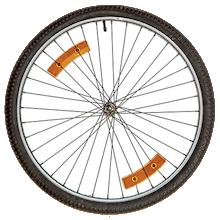
17. Colour shape that look like object.




13. Time
Reading Time on a Clock
1. Connect by line the objects with their names.

Sand clock


Mechanical clock Sundial
2. Connect by line the clock pictures with their names.




3. Write in the blanks what hours the sundial shows.



4. Write in the blanks what time clock shows.
5. Circle the clock shows 3:30.
6. Circle the clock shows 4:45.
7. Circle the clock shows 12:10.
8. Circle the clock shows 5:50.

9. Mark which class is starting now by looking on the clock.
Time table
8:30 — English
9:20 — Mathematics
10:10 — Science 11:05 — Music
Time table
10:10 — Science
11:05 — Art
12:00 — Music
12:55 — Physical Education
Time table
9:20 — Mathematics
10:10 — Music 11:05 — Art
12:00 — Science
10. Convert.
1 hr = min
1 hr 35 min = min
69 min = hr min


11. Draw the hands on the clock. 10:00 4:45 11:05

12. Convert in table.
1 min = sec
2 min 50 sec = sec 13. Convert.
125 sec = min sec
1 day = hr
2 days 2 hr = hr
36 hr = day hr
1 week = days
1 week 5 days = days
23 days = weeks days
Reading the Calendar
14. Look at the Calendar and fill in the blanks.

There are or days in a year.
There are months in a year.
There are weeks in a year.
15. Circle all month which have 31 days.
16. Circle all month which have 30 days.
17. Use the above calendar to connect dates with days of the week.
Story Problems on Time
18. Write the serial number near the story cards.

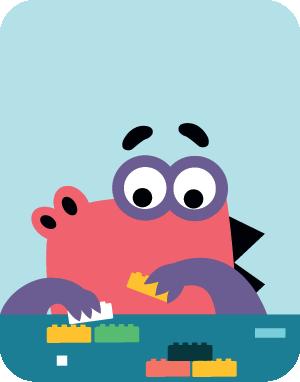







19. Read, answer the questions and write the problem solution.

Kiran spent 25 minutes on Math, 20 minutes in Science, and 15 minutes on English. How many hours did Kiran spend on all the subjects in total?
1) How much time did Kiran spend on all the subjects?
+ = (min)
2) Convert minutes in hours min = hr
20. Read, fill in the schemeand write the problem solution.
Anna left the house at 8:30. For the first 10 minutes, she walked, and then she rode in the bus for 15 minutes. At what time does Anna reach the school?

Leaving the house Boarding the bus Arriving to school ?
21. Subtract 10 min and find the right way — circle the times.
22. Add +30 min and find the right way — circle the clocks.
Maps and Directions
23. Write the directions in the correct places.

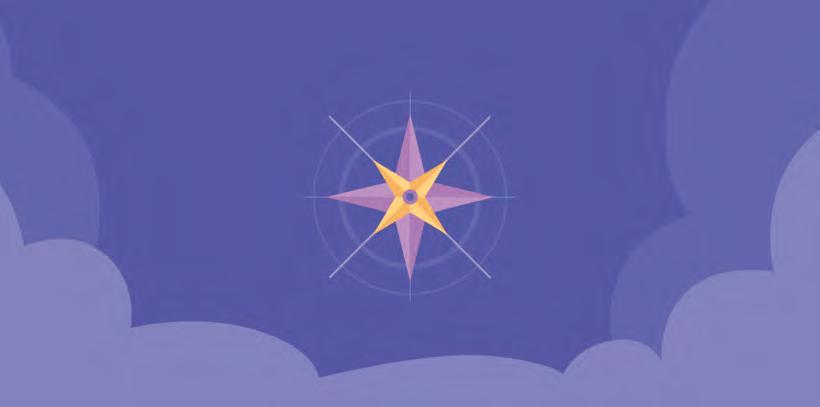
East (E)
West (W)
South West (SW)
South East (SE)
North (N)
West (W)
South (S)
South (S)
North West (NW)
North (N)
East (E)
North East (NE)
24. Look at the map. Fill in the blank in the sentences by the correct answers.
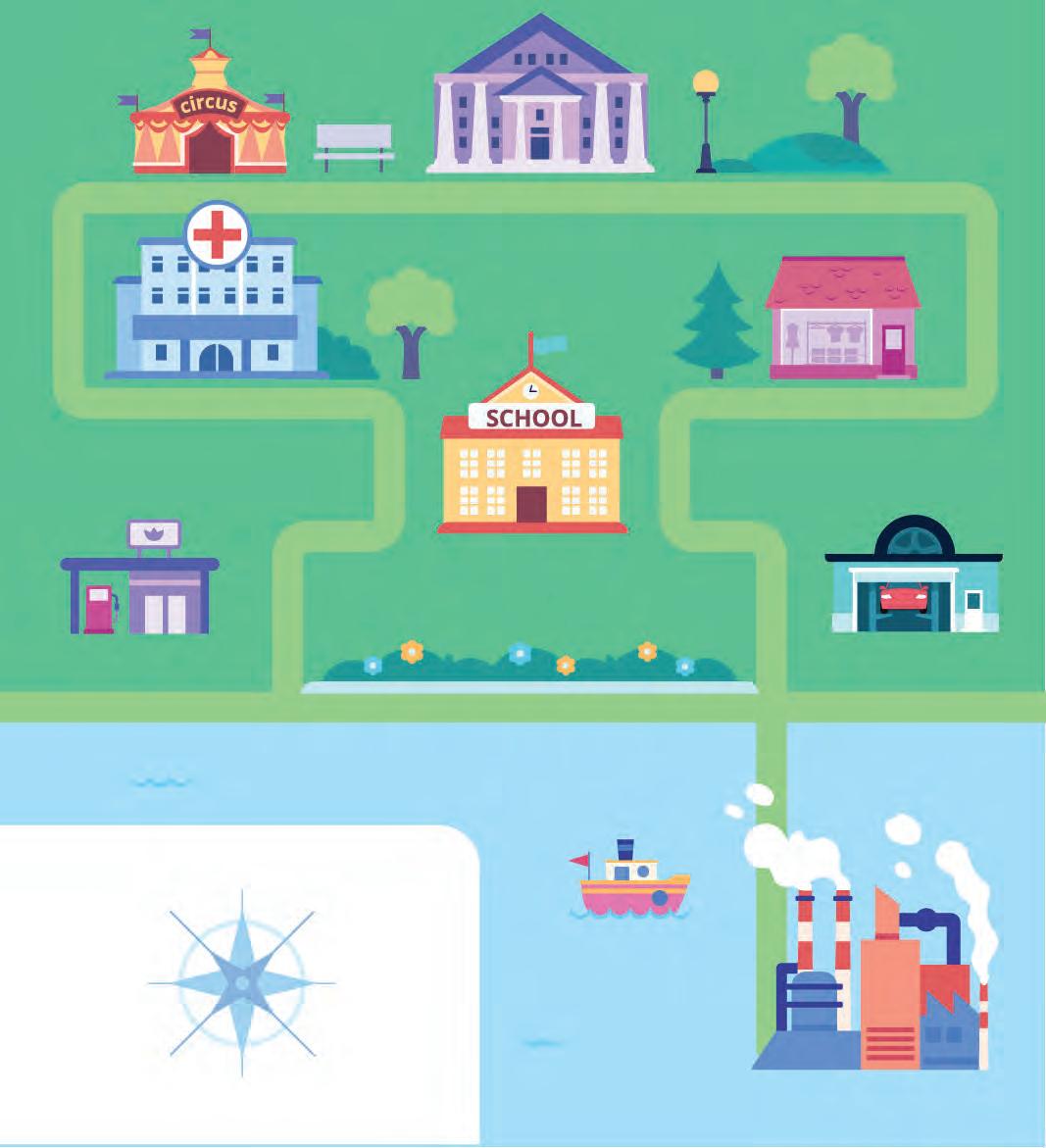
Museum is on the the school.
Market is on the of the school.
Circus is on the of the school.
Hospital is on the of the market.
Tyre center is on the of the school.
Gas station Tire center Market
1. Circle all the things we can pay with.









2. Connect with line money and their correct names.



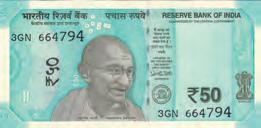

3. Circle all Indian money.








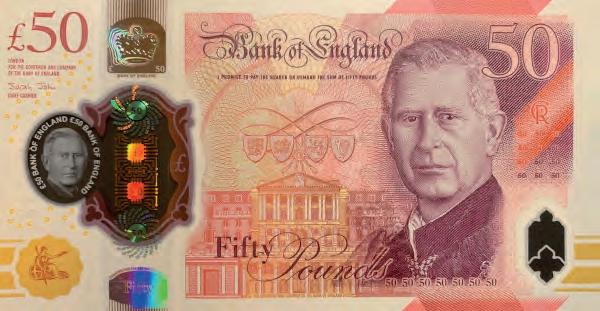
4. How much money in the wallets? Write in the blanks.








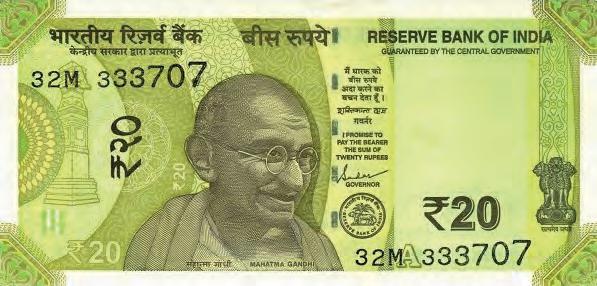



5. Circle how much money in each jar.











6. Read the comics and find the change.

I have ₹68 in my wallet.
Ice-cream costs ₹36.
I have ₹122 in my wallet.
Ice-cream costs ₹25.

₹68 – ₹36 = ₹ ₹ – ₹ = ₹
7. Write in the table how many banknotes and coins are needed for the sum.





15. Data Handling
Understanding Data
1. Draw and colour the missing ice cream in the table.
2. Draw and colour the missing figures in the table.

3. Write in the table how much banknotes and coins need for sum. fruit figure figure number number number 3




4. Look at the table and answer the questions — fill in the blanks.
Aahana Weather



The children added a + sign on the pets they own
Who has only one pet?
Who has all types of pets? __________ and __________ don’t have rabbits
How many sunny days?
What is the highest temperature for three days?
What is tomorrow night temperature?
The weather information for three days
5. Look at the picture and fill in the table by the number of the figures.


6. Write the place of cars in the race — fill in the table.
*Less time means faster!
Car Boat
7. Write the place of boats in the race — fill in the table.
8. Read and mark in the table with a + sign.
Simon likes to play football and do drawing. Lilly draws and sings



9. Connect with line the items and their correct places in the table.




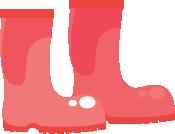
Simon Watering cans + Lily
Shovels .
10. Connect with line the correct names of the categories with their places in the table.
Berries
Fruits
Mushrooms
Vegetables




11. Connect with line the correct names of the columns with their places in the table.
Green Blue Yellow
Clothes
Footwear Red
12. Look at the table and mark the correct answer.
All activities that children do are marked with a + sign in the table.



Disha Jai Neha Tanmay Who among the children do not visit chess classes?
What activity do all the children do?
13. Look at the picture and fill in the table.
Tree height, m
Birch treeMaple
Leaf width, cm


14. Read the text and fill in the table.
Name Parth
Age


I am Tanvi. I am 9 years old. I am in 3 class. My favourite subject is reading.
My name is Parth. I am 7 years old. And I am in 3 class. My favourite subject is music.
Boy
Girl
1. Numbers up to 200
Page 1 1. 30; 5; 165
Page 2 2. 156; 138 Page 3 3. 137; 165
4 4. 171; 154 Page 5 5. 9; 2

Page 6 7. second; fifth
7


Page 8 10. third; red
9 11. 8 - even; 7 - odd; 13 - odd






2. Addition of 2-digit Numbers
3. Subtraction of 2-digit Numbers
Page 15 2.
2=
2. 64; 53; 32
Page 16
3. 62; 24; 40 4. 13; 44; 28; 32
Page 17 5.
46; 24; 15
Page 18 1. 3 similar numbers; 2 + 2 + 2 = 6 2. 4 similar numbers; 3 + 3 + 3 + 3 = 3 × 4 = 6
Page 19 3. 12 4. 9 + 9 + 9 = 9 × 3 = 27
4 + 4 + 4 + 4 + 4 = 4 × 5 = 20
Page 20 6. 3 + 3 + 3 + 3 = 3 × 4 = 12
Page 21 9. 2 × 5 = 5 × 2 = 10 2 × 5 = 5 × 2 = 10 2 × 5 = 5 × 2 = 10
Page 22 10. 2 × 5 = 5 × 2 = 10 2 × 5 = 5 × 2 = 10 2 х 5 = 5 х 2 = 10 2 × 5 = 5 × 2 = 10 11. 4 × 2; 4 + 4; 2 × 4
5. Multiplication Tables 2, 5 and 10
Page 23
1. Answer is on page 125
Page 24 2.
3. 2 × 2 = 4;
2 × 5 = 10;
4 × 5 = 20;
3 × 10 = 30; 8 × 2 = 16;
9 × 2 = 18;
3 × 5 = 15;
6 × 5 = 30;
7 × 10 = 70;
7 × 2 = 14
6. Numbers up to 999
Page 25
1. 826: eight hundred, twenty, six
374: three hundred, seventy, nine
Page 26 2. 259; 308; 867
Page 27 3. 279; 2 hundreds + 5 tens + + 4 ones = 254
Page 28
4. 358 = 300 + 50 + 8 843 = 800 + 40 + 3 619 = 600 + 10 + 9 5. 493 = 400 + 90 + 3 861 = 800 + 60 + 1
Page 29
6. 5 + 800 + 10 = 815
900 + 8 + 50 = 958 2 + 60 + 400 = 462
5 + 600 + 30 = 635 90 + 8 + 200 = 298
Page 30 7.


Page 31
8. five hundreds: 578; 549
five hundreds: 959; 934; 966 three ones: 663; 273
Page 32 9.


7. Addition and Subtraction of 3-digit Numbers
Page 33 1. 978; 895; 836; 769
2. 812; 635; 855; 986; 794; 819; 823; 992 Page 34
35
5. 399; 789; 788 6. 455; 306; 397
Page 36
7. 620; 103; 211
8. 113; 416; 691; 412
9. 289; 176; 298; 194
Page 37
10. 188; 216; 189; 139
11. 261; 222; 406; 85
12. 521; 202; 260; 78; 664; 102
Page 38
13. 6 min; 6 legs
Page 39
14. 7 balloons
15. 7 – 4 = 3 (r.); 6 + 3 = 9 (l.)
Page 40
16. 9 photos; 6 braids; 9 problems; 8 words
8. Multiplication Tables 3, 4 and 6
Page 42 2. 3. 3 × 4 = 12; 4 × 4 = 16; 4 × 6 = 24; 3 × 6 = 18; 3 × 8 = 24; 4 × 6 = 24; 3 × 3 = 9; 9 × 6 = 54; 4 × 8 = 32; 8 × 6 = 48
Page 44 5. 92; 18 × 5 = 10 × 5 + 8 ×
Page 45 6. 5 × 10; 4; 2
+
Page 46
8. 92; 588; 184
9. 3 × 18 = 54; 49 × 2 = 98; 23 × 3 = 69; 11 × 8 = 88; 12 × 8 = 96; 4 × 13 = 52; 19 × 4 = 76; 7 × 14 = 98; 17 × 5 = 85; 12 × 7 = 84; 24 × 4 = 96; 3 × 31 = 93
9. Introduction to Division
Page 47 1.









































































Page 52
7. 12 ÷ 4 = 3;
12 ÷ 2 = 6;
18 ÷ 3 = 6
Page 53
8. 20 ÷ ? = 2; 27 ÷ 3 = ?
Page 54
9. 8 ÷ 2 = 4; 12 ÷ 3 = 4
10. 45 ÷ 5 = 9; 12 ÷ 4 = 3;
30 ÷ 3 = 10; 15 ÷ 3 = 5;
16 ÷ 2 = 8; 28 ÷ 4 = 7;
6 ÷ 3 = 2; 15 ÷ 5 = 3;
18 ÷ 2 = 9; 40 ÷ 5 = 8;




Page 56 4. 5. halves; thirds; quarters; quarters
Page 57 6. ½; ¼; ⅓; ½
Page 58

14 ÷ 2 = 7; 27 ÷ 3 = 9 Page 55
8. 8/9; 2/9
10. Introduction to Fractions




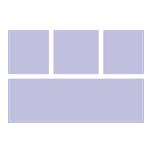










Page 59 9. 10.





60 11.
Denominator
Numerator
Fraction bar




513 and 135
Fractions with different numerators
Fractions with equal numerators 87 and 33 1233 and 1717 1010 and 57
11. Measurement
Page 61
1. 4; 5; 6
Page 62
2. 9 cm; 6 cm; 7 cm; 3 cm; 8 cm; 4 cm Page 63 3.
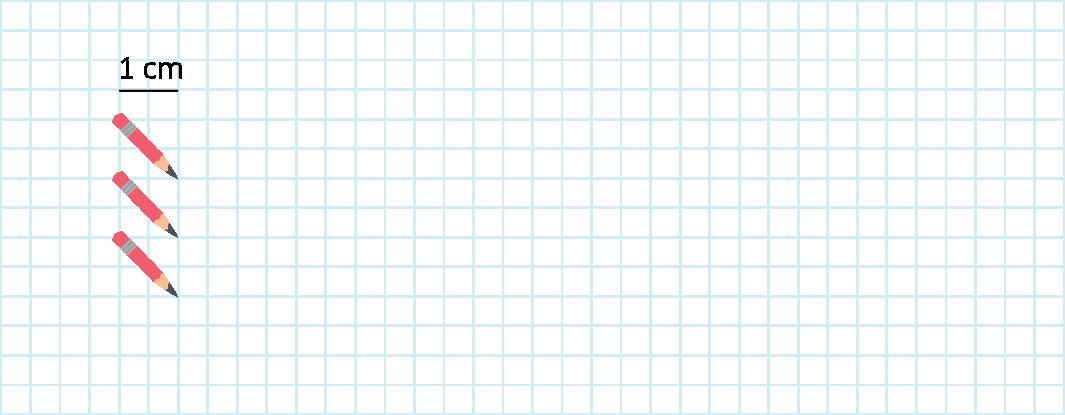

66 9. 10. 11 14
4. 5 cm; 4 cm; 9 cm Page 64 5. 6.

65 7. 5 cm; 4 cm


Page 67 11. Metre
12.

Page 68
13. 18 cm; 13 cm; 14 сm
Page 70
16. 7 kg; 3 kg; 9 kg; 1 kg; 4 kg
Page 71
17. melon; same; melon
Page 72
18. melon; chameleon; bananas
Page 73
19. 5 kg; 3 kg
20. 2 kg; 1 kg

Page 69 14. 15.








Page 74
21. 6 kg; 6 kg
22. 7 blocks; 6 blocks
Page 75
23. 4 L of juice and 3 L of water; 4 L of soap, 1 L of washing powder and 3 L of shampoo
24. Litre
Page 76 25.








Page 77
26. 3L + 4L = 7L; 2L + 4L = 6L
Page 78 28. 3L
29. 3L
12. Shapes and Patterns
Page 79 1. infinite; one

81
4. closed figure/ line segment; straight line / point; curve / straight line; ray / curve; ray / open figure
Page 82 5.
Page 85 11.

Page 84
9. Triangle has 3 vertices and 3 sides. Quadrilateral has 4 vertices and 4 sides. Hexagon has 6 vertices and 6 sides. 10.
Page 86 13.













Page 90 3. 11hr; 3hr 4. 1 hr 15 min; 4 hr 40 min
Page 91 6-8. 4:45; 12:10; 5:50


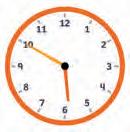
Page 92 9. 9:20 — Mathematics; 12:55 — Physical Education; 11:05 — Art
Page 93 10. 1 hr = 60 min 1 hr 35 min = 95 min 69 min = 1 hr 9 min






Sand Mechanic Sundials
Page 94 12.
Page 96
14. There are 365 or 366 days in a year. There are 12 months in a year. There are 52 weeks in a year.
Page 98 17. hours3247
Page 95
13. 1 min = 60 sec
125 sec = 2 min 5 sec
2 min 50 sec = 170 sec
1 day = 24 hr
2 days 2 hr = 50 hr
36 hr = 1 day 12 hr
1 week = 7 days
1 week 5 days = 12 days
23 days = 3 weeks 2 days
Page 97
15. January, March, May, July, August, October, December
16. April, June, September, November
Page 99 18.









Page 100
19. 25+20+15=60 (min); 60 min = 1 hr
Page 101 20. 10+15 = 25 (min); 8 hr 30 min + 25 min = 8 hr 55 min
Page 102 21.

Page 102 22. Page 103 23.


Page 104 24.
Museum is on the N of the school. Market is on the NE of the school. Circus is on the NW of the school. Hospital is on the W of the market. Tyre center is on the SE of the school.
South West (SW)
East (SE) North (N) North West (NW)
(E)
Page 105 1. Coins; a bank card; banknotes




Page 107

₹ 68; ₹ 122 Page 108 5. ₹ 14; ₹ 76; ₹ 114 Page 109 6. ₹ 32; ₹ 122 - ₹ 25 = ₹ 97
110









115 6. Place: 5; 2; 4; 1; 3
7. Place: 2; 4; 5; 1; 3
116

Page 113
4. Aahana; Palak; Aahana and Vinod; 2; +24; +13 Page 114
Blue; Red; Green figure






117
Vegetables; fruits


